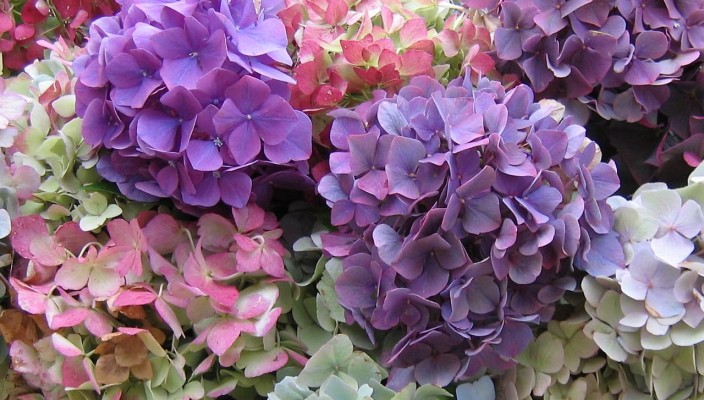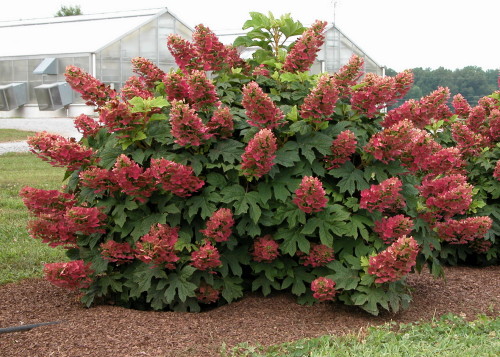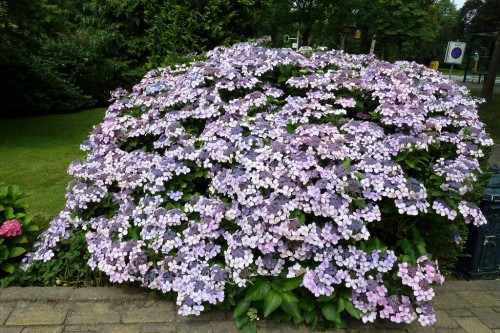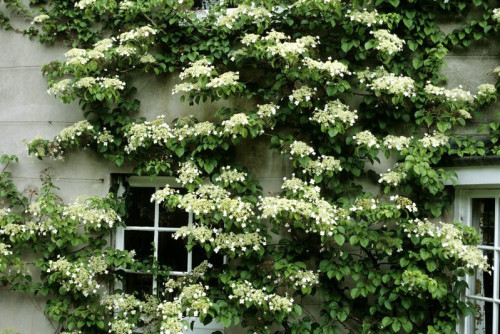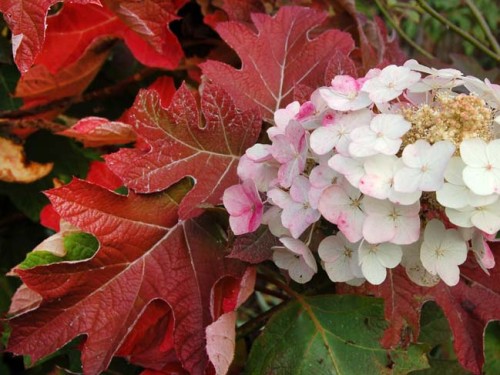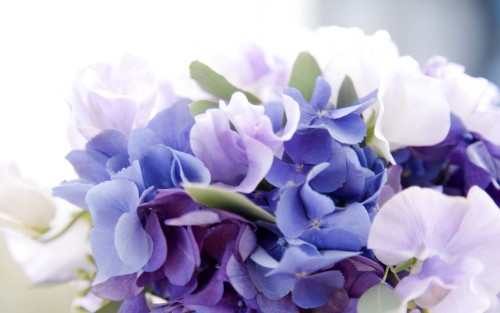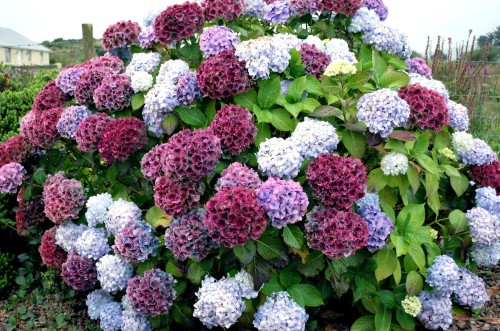Many gardeners appreciate Hydrangea for its unpretentiousness, a magnificent appearance, a huge amount of varieties and colors, wonderful decorative qualities. This shrub perfectly tolerates cold winters, which allows you to grow it in the climatic conditions of our country. Hydrangea looks beautifully both in itself and in flower arrangements. Its dense buds, abundantly covering bushes, can change the shade several times during the flowering season, which continues until the very beginning of frosts.
Content
Types of hydrangea
Tree hydrangea
Gardeners know this culture under such names: "Hydrangea bush" or "white spherical hydrangea". A bush of this plant reaches a height of 1-3 m, the location of its origin is considered the countries of North America. A large size of the leaves has a non-unique color: they are saturated from above, and they have a squeezed tide from below. The boutons of the tree hydrangea have a flat or spherical shape, in diameter of inflorescences reach 10-20 cm. At the beginning of flowering, the petals are painted in a white and greenish tint, and over time they acquire a snow-white or cream color.
For most varieties of tree hydrangea in a quantitative sense, fruiting flowers prevail, while the number of sterile inflorescences is relatively small. But there are also varieties giving a large amount of empty flowers.
This variety of culture is distinguished by unpretentiousness, the ability to wear cold and frost well. Hydrangea tree is growing perfectly in the shaded areas of the garden. Annual shoots that do not have time to mature to winter, with the onset of frosts frost. But after the spring trimming, the plant is restored in a short time and gives bloom in the coming season. In the Russian gardens, the tree hydrangea produces buds a little earlier than other types of culture, its flowering period lasts from July to November.
A close view of the tree hydrangea is hydrangea gray. Unfortunately, it will be infrequently visited on the expanses of our country, although in its frost-resistant and shadowless characteristics, it even exceeds the previous variety of culture.
Hydrangea Misbulataya
Miscellaneous hydrangea is a shrub whose height reaches from 2 to 5 m. This plant can often be found in hot countries: Japan, China, southern Sakhalin. This culture is loved by Russian gardeners for excellent decorative properties. It can be used in landscape design, giving the shape of a bush or even a multiform tree. Hydrangea is differ in longevity, it can grow in the same place for 40 years.
The stalks of this plant have the ability to rush quickly, thanks to which the hydrangea perfectly transfers even strong frosts. Culture foliage has an oblong shape, buds are blown up on young shoots in the very first year than the due to abundant and lush flowering. The first flowers appear on the bushes back in June, flowering peak falls on August-September. Buds have a pyramidal shape, they are present in both fluttering flowers and empties. At the beginning of the season, the flowers have a greenish-white color, which subsequently turns into a purely white or beige. With the arrival of autumn, buds acquire a pinkish shade, which over time goes into terracotta and purple.
Thanks to the winter hardiness, the hydrangea hill is perfectly making a strong cold, many gardeners do not even cover bushes for the winter. The most popular variety of this species is the Hortension "Grandiflora". It is characterized by large buds reaching a length of 30 cm. Flowers in such buds are almost all sterile, a bit of cheering inflorescences are located at the very top of the brush.
Hydrangea hydrangea
Among the gardeners, this type of culture is customary called garden hydrangea. She, like the previous variety, is widespread in countries with a warm climate: in Japan, China and Sakhalin. In the wild, the height of the shrub is 4 m, but an aluminous plant grows not higher than 1-2 m. When planting a hydrangea of \u200b\u200ba garden to vases or containers, it is better to pick up low grades whose height does not exceed 0.5-0.6 m.
This culture has a saturated green and sufficiently dense foliage. Old branches are covered with dense bark, young shoots - green and grassy, \u200b\u200bbegin to rush around one year after the appearance. The plant does not differ in high coolness, young branches with severe frosts may die. In connection with this feature, the care of the hydrogen-sized garden should include the mandatory shelter of shrubs for the winter.
Buds of plants bloom in annual escapes, where flower kidneys are laid from autumn. There are several varieties among this species, which differ from each other with sizes and form of inflorescences, as well as a shade of petals. The most common subspecies is a Japanese hydrangea, having umbrella and municipal buds, as well as hydrangea change, which has a semi-shaped inflorescence. The changeable hydrangea has an unstable color, which largely depends on the composition of the soil. For example, in neutral soil, the petals of the plant have a pink tint, but the hydrangea buds will be blue, if you put a shrub in the acidic soil. The color gamut of large hydrangea has a very wide range, buds can be snow-white, pink, saturated-red, dark blue, purple. Pink and blue varieties can change their shade depending on the features of the soil. So that the buds constantly retain the blue color, you can periodically add iron vigor or a solution of aluminum-potassium alum - these substances constantly acidify the soil.
Pillya hydrangea
This species is a close relative of the previous species. Pilly hydrangea is similar to hydrangea garden in size and shaped buds, features of growth, landing and care rules. Just like a large view, this culture changes the color of the inflorescences depending on the composition of the soil. Often the beads of the sawmill hydrangea are mixed coloring: fluttering flowers are painted in blue gamut, and sterile flowers have petals of pink shade. The common variety of this species is "Blue Bird", the inflorescences of which are completely painted in blue.
Cherry Hydrangea
This variety of culture is a curly perennial plant, its Liana is widely used in landscape design. Initially, the cherry hydrangea grown on the Kuril Islands, in China and Japan, as well as in some areas of southern Sakhalin. In the warm climate of these countries, the wild plant lianas reach a length of 25 m, but an indulged species present in the Russian gardens has significantly smaller sizes.
When planting a cherry hydrangea, it is important to take into account the characteristics of the structure of the culture. Since this is a liana, she should provide a support for which stems will be. Without having a support, the cherry hydrangea can simply step on the ground, but in this case it is pointless to wait for her.
The foliage of the plant has a heart-shaped form, the inflorescences of an umbrella type, loose, in diameter reach 15-25 cm. The shade of petals can be white and green, pink, lilac. Culture is sufficiently resistant to cold, but in particularly strong freezing it is better to cover it. In addition, in front of wintering, young Liana is desirable to shoot with support and leave on the ground so that the plant has worried cold under the layer of snow.
Dollandic hydrangea
When planting a dabutant hydrangea, it should be borne in mind that this type is not so frost-resistant as some other species, so the shrubs need to be well covered by winter. Decorative qualities of this culture are caused not only beautiful delicate bud and bloom long period, but also excellent foliage, which with the onset of the fall is colored bright red.
Hydrangea raznosherstistaya
This plant received its name due to the original leaves, the upper part of which has a smooth surface and bright green, and the lower - has a lighter shade and covered with a pile. In the Far East, hydrangea can be found in the undergrowth, where it grows like soil-level culture and covers the ground with a dense carpet. Meanwhile, the plant does not apply to the soil, since it has quite durable, solid and long branches.
A common variety of culture is the hydrangea of \u200b\u200bthe Bretenner. The plant has the foliage of the extended form, as well as durable shoots that are covered in a short time with solid bark. The inflorescences of Kalinovoid, initially have a white color, which subsequently darkens. Despite the unpretentiousness, frost resistance and teotalemability, the Hortensia of the Bretennister can be infrequently found in the sections of Russian gardeners.
Features of planting hydrangea
Before boarding the hydrangea to the ground, it is necessary to prepare the correct composition of the soil. This plant is doing well in the ground with a weakly acidic or medium-sized composition. To prepare soil, mix the same amount of sand, sod of land, peat, humid and leaf land. The ability of some varieties to change the colors of buds depending on the acid-alkali composition of the soil makes it possible to judge the soil reaction. For example, the land with a slightly alkaline reaction will paint the petals of the plant into the pink range, whereas blue and blue buds will bloom on acidic soils.
The choice of landing sites of the hydrangea also need to pay due attention. Most cultural varieties prefer shaded areas, but there are also such varieties that the sun is more like. In any case, putting shrubs in a mild half, you will not be mistaken. It is extremely recommended to plant a culture near large trees, as the latter pull a lot of moisture out of the ground. Place a flowerub with hydrangeas under the scorching sun is also not worth it, because the soil in such places is often overwhelmed, which is not the best way to reflect on the state of plants. On the excessive shaded areas of hydrangea begin to bloom later, and buds can be small.
The landing of hydrangea is better in spring, after the end of the last frost and sufficient soil warming. If you plan to plant several shrubs on one site, provide them with sufficient space, making the distance between individual plants at least 1 m. Small culture seedlings are bought to a depth of 35 cm, for sufficient large bushes it is necessary to dig a deeper pit. Before boarding the hydrangea, provide it with good drainage: Pass on the bottom of the pit layer of sand, rubble or clay, and then fill out the deepening of the prepared soil in advance.
Together with the landing of hydrangea to the ground, do not forget to add organic and mineral fertilizers - so you will ensure the rapid formation of flower kidney in the future. After the seedlings are insoles and politics, the land around the stems need to be closed. The mulch layer will allow the moisture for a long time after irrigation, and the hydrangeas love good moisture. As a mulch, you can use cheese, wood sawdust, peat, pouring the selected layer material to 10 cm. During the season, the mulch should be loosened several times.
Care for hydrangea
Watering hydrangea should be carried out with soft water, since the plant does not like lime. It is best to store rainwater in advance, but if there is no such possibility, then you can simply defend ordinary water from the water pipeline. The temperature of the watering fluid should also be acceptable - not lower than room. A little lemon juice, vinegar or electrolyte can be added to the tap water - this will help protect the plant from chlorosis of leaves. For the same purpose, iron vigor can be made to the soil, iron chelate or ferrophite. Hortensia refers to moisthed plants, one of its bush should have at least 2 buckets of water per week. In the rainy season, the irrigation rate can be 1-2 times a month.
When growing large hydrangea, it is possible to achieve a blue color of petals, constantly acidifying the soil of iron salts and alum. To prepare the desired composition, dissolve in 2 liters of water 8-10 ammonia-potassium or alumokalia alum. Mineral formulations can also be used as feeding, and it is better to refuse. Hortensia is customary to fertilize several times per season:
- The first feeding is carried out in the spring when young shoots begin to grow.
- The second feeding should be made in June, since it is at this time on the branches of the plant are inflorescences.
- The third time of the hydrangea fertilizes during their flowering, so as to extend this time and ensure the formation of flower kidney in the future season.
Young plants in the first year after landing are watered with a solution of potassium permanganate, so as to protect the culture from the formation of rot. Instead of manganese, you can also use phytosporin.
Hortensia in the open ground should also be properly prepared for wintering. At the end of autumn it is important to provide a rich watering plant. If the weather is not rainy, try to water the culture as often as possible - successful wintering will depend on sufficient moisture. So that the shoots did not begin to be installed under the underfloor material, treat them to the Bordeaux mixture. In the last decade of October, when the night temperature lowers low, perform a 30 cm altitude, then cover the bushes with a polyethylene film or agrospan. At the end of the autumn, when strong cold will come, warm the culture branches with a snack or dry foliage.
Diseases and pests of culture
Hydrangea is badly leaving for alkaline soils, starting to suffer chlorosis. This disease is manifested by changing the color of foliage - it becomes lighter, acquires a yellowish tint, while the streaks remain green. To avoid the development of chlorosis, try to use only soft water when irrigated, and in the soil periodically add iron salts. You can saturate the soil with solutions of nitric acid potassium and iron mood.
With a strong drought, hydrangea is subjected to a paustic tick attack. He causes drying and loss of foliage, get rid of the tick helps the irrigation of the bushes with the drug "Aktellik".
If you have noticed oil stains on the leaves of hydrangea, which in the time you purchased a yellow tint, then your culture fell ill with false torment. If you do not cure with hydrangea on time, the stains will noticeably increase in size, they will merge and darken. Especially often such a disease occurs under the influence of high humidity and heat. To prevent the development of false powdered dew or correct the current situation, treat bushes with solutions of fungicides.
In case of cheese and cold climates, hydrangea is subject to rust formation. The prevention of this disease uses periodic irrigation of escapes with a solution of copper sulphate.
A burgundy mixture will help to cope with such a problem as septoriasis, burgundy liquid or solutions of fungicides. Among other things, in the winter period, the hineshic bushes are affected by mice. To protect the plants from damage to rodents, scatter near the bushes special means from rats and mice.
Plant reproduction
The most common way of reproduction of culture is considered to be shovel, some gardeners carry out the landing of hydrangea by seeds or letters. The cuttings are harvested in autumn, cutting fragments of young shoots and rooting them in greenhouses or in greenhouses.
Bust division is better to exercise in the spring. At this time, the bush needs to dig out of the ground and determine where the renewal kidney is located. In accordance with these kidneys, the bush is divided into fragments. Damaged places are treated with ash or crushed charcoal, the dealers can be immersed in a stimulating solution that will speed up the root growth process.
Another effective way of reproduction of hydrangea is the formation of messengers. This process is carried out sufficiently simple: annual shoots bend to the ground and fixed in the place where the kidney is located. To increase the chances of germination of the roots, the place near the kidney needs a little scratch and treat the drug "Korniner". Then the fixed place is sprinkled with soil, leaving the tip of the escape over the ground. In the spring of next year, the rooted stem can be cut off from the parent plant.

